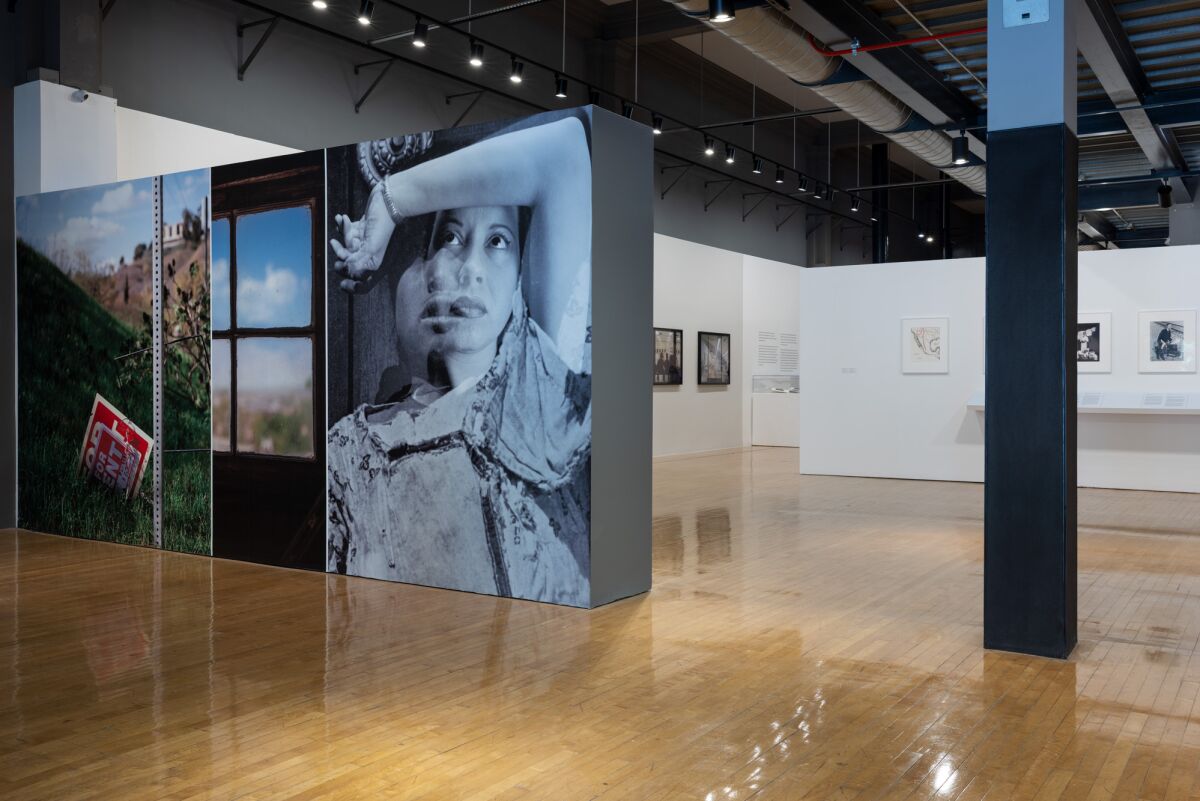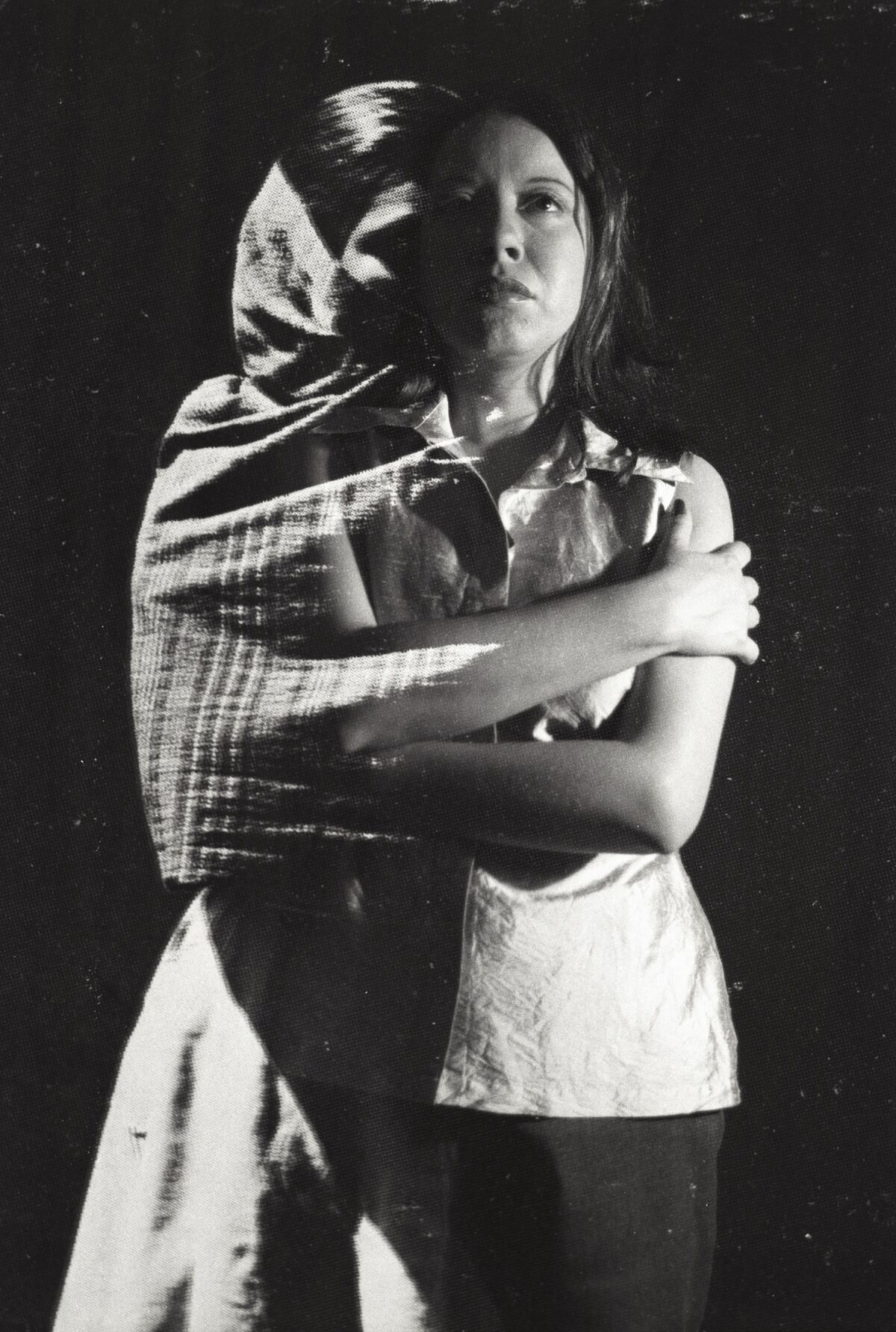In 2010, Christina Fernandez made a panoramic landscape photograph 20 inches high and six feet wide. The extreme format is unlike anything in her work before or since. At the very least it indicates an eager curiosity and desire to experiment, which has been a through-line in her challenging art over the course of 30 years.
Fernandez was born in Los Angeles in 1965 and received her BA from UCLA in 1989 and MFA from the California Institute of Arts in 1996. She has been on the faculty at Cerritos College in Norwalk for three decades. Her career is now the subject of an engrossing exhibition at UC Riverside’s California Museum of Photography. It comes with an excellent catalog assembled by its curator, Joanna Szupinska, including six additional authors, and is happily set to travel to five museums across the country.
The panorama, which comes near the end of the installation, touches on themes and concerns that turn up again and again in Fernandez’s work, albeit in a distinctive way. That begins with the visual specificities of camerawork.
It’s not possible to take in everything at once in a skinny panorama six feet wide, as it might be in a more conventional 8-by-10 print, since you can’t see both ends unless you move to the other side of the room, now too far away to take in essential details. Instead, moving in closer, your eye scans the scene, as if you’re looking around.
That’s the opposite of how we mostly look at photographs now, glimpsed in a quick bite on a phone screen.

“Christina Fernandez: Multiple Exposures” surveys 30 years of the L.A. artist’s photographs
(UCR California Museum of Photography)
What Fernandez shows is fairly ordinary — an empty lot on a suburban bluff, with a cluster of unlovely apartments and passing cars in the background at the right and a vista looking out over a leafy neighborhood of private homes to a hazy mountain peak in the distance at the left. (Think Paul Cézanne’s “Mont Sainte-Victoire.”) At the center, the blur of a young boy running across the scene pulls your eye to the broken concrete slab of a long-demolished building he traverses, then to the rickety chain-link fencing that surrounds the empty lot. Weeds are popping up, the scrub in the middle distance has turned golden and the serene sky above is a gradation of pale blues.
Suddenly, the space being photographed in “El Sereno Ruin (Diego)” seems discomfited — a contemporary deterioration as provocative as any in the lexicon of photographic history, whether Timothy H. O’Sullivan documenting ancient cliff dwellings in Canyon de Chelly or John Beasley Greene chronicling tumble-down Egyptian monuments at Thebes, both in the mid-19th century. The ruined empty lot with the boy running through is a place of transition, perhaps cyclical, between nature and culture. That the site appears ordinary, as routine as an endless number of Southern California places, adds a layer to the unsettled response.
Fernandez’s work is an important pivot between classic Chicano art celebrating Mexican and Mexican American identity, raised in the face of oppressive stereotyping, and a more fluid and open-ended Conceptual structure that shakes things up. She works in series, turning an idea over in a variety of ways to undermine presumptions of any single photograph’s comprehensiveness. The show opens with two juxtaposed sets of photographs.
For “Maria’s Great Expedition” (1995-1996), the artist assumed the role of her grandmother, who immigrated to the United States from Morelia, Mexico, in 1910. Six mostly black-and-white set-pieces begin by showing her as a 14-year-old, wrapped in a rebozo, gazing into the unknowable far distance as one among the million Mexicans who headed north, pushed by the chaos of revolution at home and pulled by the demands of cheap labor from American industrialists.
Five show episodes in Colorado, Arizona and California, plus a return trip to Morelia, in Mexico’s Michoacán state. They end with a color photographic scene in 1950, a subtle shift in camera technology marking time. Maria, now mature, is standing hunched by a stove making tea, a discount-store advertisement featured in the newspaper rolled up under her arm.
Nothing epic happens in this six-episode costume drama, except for the singularity of a life lived during an era of enormous change, which is a source of its soulful, closely observed charm. (A favorite detail: She’s seated on a footlocker waiting for a train to carry her to Mexico for a visit, and a bit of crocheting draped across a knee, its yarn trailing off into the satchel at her feet, neatly embodies the passage of time.) Fernandez’s photographs recall Cindy Sherman’s dress-up play, based on archetypes produced by mass media, and Eleanor Antin’s photographic narratives of famous women and men, in which the artist tries on various historical roles. Here, the personal nature of telling (and imagining) a familial story has the effect of immortalizing a life otherwise erased.
The second body of work in the first room couldn’t be more different, although it continues a thread — literally in the case of an embroidered piece of muslin installed at the start. Color photographs from 1996 — flat, frontal, emphasizing the two dimensions of the picture plane — show the gated and graffiti-tagged facades of rundown buildings in downtown L.A.’s garment district. The text embroidered into muslin, like a modernized Southern California version of Colonial-era New England samplers, narrates a harrowing scene of a seamstress avoiding agents of la migra — immigration — a black thread tangled on the heel of her shoe threatening to give away her hiding place. The black thread of Fernandez’s embroidery piece is all about exposure — not coincidentally, a photographic term.
Formally, Fernandez’s flat and anonymous sweatshop facades turn photography’s New Topographic movement, influential since the 1970s, on its head. Her shuttered buildings might appear anonymous, but the structures they record fairly vibrate with the feeling of hidden activity inside. We commonly look through the surface of photographs, as if they were transparent transcriptions of the world before the camera’s lens. By contrast, Fernandez’s garment district pictures are locked and loaded — anything but transparent.

Christina Fernandez, “Multiple Exposure #4 (Bravo),” 1999, archival pigment print
(UCR California Museum of Photography)
These two bodies of work set up the photographs for which the artist is best-known, 10 pictures of the glass fronts of coin laundromats at night. (“Lavanderia #4” graced the catalog cover of “Phantom Sightings: Art After the Chicano Movement,” the influential 2008 show at the Los Angeles County Museum of Art.) Domestic labor in Latino neighborhoods is charted, men and women glimpsed with washing machines through a scrim of graffiti scrawled on the windows. The tensions between “cleaned” and “sullied” glow from nighttime inner illumination, throwing photographic transparency into turmoil. These are “nighthawks” as surely as Edward Hopper’s famous painted coffeeshop denizens during wartime are, but of a wholly different if equally poetic kind.
Other series include “Multiple Exposures,” in which she merges self-portrait negatives with images by celebrated camera artists, including Manuel Álvarez Bravo, Nacho López, Tina Modotti and Gabriel Figueroa Mateos; and “View From Here,” fuzzy shots of landscapes out the window of other artists’ residences — Noah Purifoy in Joshua Tree, for example, or Toyo Miyatake at the Manzanar concentration camp. Fernandez’s images conduct visual conversations with fellow artists who, given their notoriety, both frame her work and are contradicted by it.
The “Multiple Exposures,” for which the retrospective exhibition is named, are especially compelling. The merger of her own face with celebrated camera pictures of Mexican people at once honors, elevates and blurs identity. In the haunting “#4,” she poses embracing herself, plus Bravo and the picture’s anonymous woman wrapping herself in a rebozo. A multiple pictorial identity is made from photographic fragments, giving up any claim to a single cultural character.
Not all the work resonates. A series on studio spaces she has vacated over years is inscrutably blank, although it does chronicle a nomadic life and valorize Fernandez’s commitments as a working artist. And two small current shows that Fernandez organized further demonstrate her collegiality — “Tierra Entre Medio,” also at the California Museum of Photography, assembles work by three like-minded Chicana photographers; and “Under the Sun,” at Benton Museum of Art at Pomona College, puts her photographs in dialogue with objects she selected from the museum’s collection. Community, multiplicity and discourse among artists are exemplary watchwords of her photographs.
‘Christina Fernandez: Multiple Exposures’
Where: UC Riverside’s California Museum of Photography, 3824 Main St., Riverside
When: Thursdays to Sundays through Feb. 5
Cost: Free
Info: (951) 827-4787, ucrarts.ucr.edu
Stay connected with us on social media platform for instant update click here to join our Twitter, & Facebook
We are now on Telegram. Click here to join our channel (@TechiUpdate) and stay updated with the latest Technology headlines.
For all the latest Art-Culture News Click Here
